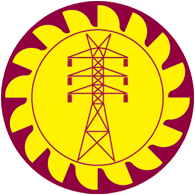
The Ceylon Electricity Board - CEB, is the largest electricity company in Sri Lanka. With a market share of nearly 100%, it controls all major functions of electricity generation, transmission, distribution and retailing in Sri Lanka. It is one of the only two on-grid electricity companies in the country; the other being Lanka Electricity Company (LECO). The company earned approximately Rs 204.7 billion in 2014, with a total of nearly 5.42 million consumer accounts. It is a government-owned and controlled utility of Sri Lanka that takes care of the general energy facilities of the island. The Ministry of Power and Energy is the responsible ministry above the CEB. Ceylon Electricity Board (CEB), established by the CEB Act No. 17 of 1969, is under the legal obligation to develop and maintain an efficient, coordinated and economical system of electricity supply in accordance with any licenses issued.

The Lakvijaya Power Station is the largest power station in Sri Lanka.

The electricity sector in Sri Lanka has a national grid which is primarily powered by hydroelectric power and thermal power, with sources such as photovoltaics and wind power in early stages of deployment. Although potential sites are being identified, other power sources such as geothermal, nuclear, solar thermal and wave power are not used in the power generation process for the national grid.
The Sampur Power Station was a proposed coal-fired power station that was planned to be built in Sampur, Trincomalee, Sri Lanka.

NTPC Limited, formerly known as National Thermal Power Corporation, is an Indian central Public Sector Undertaking (PSU) under the ownership of the Ministry of Power and the Government of India, who is engaged in the generation of electricity and other activities. The headquarters of the PSU are situated at New Delhi. NTPC's core function is the generation and distribution of electricity to State Electricity Boards in India. The body also undertakes consultancy and turnkey project contracts that involve engineering, project management, construction management, and operation and management of power plants.

The Mampuri Wind Farms are a set of three wind farms located near the Lakvijaya Power Station, on the Kalpitiya peninsula, in Mampuri, Puttalam District, Sri Lanka. The wind farms, referred to as Mampuri-I, Mampuri-II, and Mampuri-III, was built successively, and consists of eighteen Suzlon wind turbines ranging from 1.25 MW to 2.10 MW. Mampuri-I was commissioned on 22 March 2010, and was the first wind farm in the country to reach the 10 MW installed capacity threshold. As the government only allows projects up to 10 MW, the three wind farms are registered under three different company names, namely Senok Wind Power, Senok Wind Energy, and Senok Wind Resource.

The Uppudaluwa Wind Farm is a 10.5 MW wind farm owned by PowerGen Lanka (Private) Limited in Uppudaluwa, Puttalam, Sri Lanka.

The Yugadanavi Power Station is a large oil-fired power station in Sri Lanka. The 300 MW power station is located in Kerawalapitiya, in the Western Province of Sri Lanka.
Air Senok (Pvt) Ltd is a domestic carrier based in Sri Lanka specializing in various charter services such as passenger transport, emergency medical evacuation, Aerial advertising, photography and filming. Their main base of operations is at the Ratmalana Airport in Colombo, Sri Lanka. They operate three Airbus H125 helicopters.

The Madurankuliya Wind Farm is a 12 MW wind farm located in Narakkaliya, bordering the Lakvijaya Power Station, in Narakkaliya, Puttalam, Sri Lanka. The wind farm is operated by Daily Life Renewable Energy (Pvt) Ltd, a subsidiary of WindForce (Pvt) Ltd, which owns most of the existing wind farms in the country. The facility consists of eight ReGen VENSYS 82 wind turbines of 1.5 MW each. With a hub height of 85 m (279 ft) and a rotor diameter of 82 m (269 ft), these turbines has rated wind speeds of 13 m/s (43 ft/s), despite the site only experiencing about 7.4 m/s (24 ft/s). The wind farm experiences air densities of 1.158 kg/m3 (0.072 lb/cu ft).
The Pawan Danavi Wind Farm is a 10.2 MW onshore wind farm located near Kalpitiya, in the Puttalam District of Sri Lanka. The wind farm utilizes twelve of Gamesa's G58-850 kW wind turbines. Pawan Danavi is a subsidiary company of LTL Holdings.
The Nilambe Dam is a small hydroelectric dam build across the Nilambe River, measuring approximately 70 m (230 ft) in length. Water from the Nilambe Dam is transferred to the 3.2-megawatt Nilambe Power Station through a 2.8 km (1.7 mi) penstock. The power station consists of two 1.6 MW generating units, which were commissioned in July 1988.
The Ace Embilipitiya Power Station is a 100 MW thermal power station in Embilipitiya, Sri Lanka. The heavy fuel oil-run power station was commissioned in March 2005, and was operated by Aitken Spence. The power station consisted of fourteen Caterpillar 16CM32C generation units of 7.11 MW each, which consumed approximately 550 tonnes of fuel oil per day. The Ministry of Power and Energy discontinued purchasing power from the private power station after its license expired in 2015, and hence was subsequently decommissioned.
The Asia Power Sapugaskanda Power Station is a 51 MW thermal power station in Sapugaskanda, Sri Lanka. Planning for the fuel oil-run power station dated back to 1994, when the Ceylon Electricity Board issued a tender for an IPP project for 50 megawatts. Construction of the plant began in 1996 and was commissioned in June 1998, with a PPA of 20-years. The power station utilizes eight Deutz 16V BVM 640 generating units.
The Uthuru Janani Power Station is a 24-megawatt thermal power station commissioned on 1 January 2013, in Chunnakam, Sri Lanka. The power station consists of three diesel-run generating units with a capacity of 8 MW each, producing 176 GWh annually. Built and operated by the Ceylon Electricity Board for Rs. 3.5 billion, the power station costs Rs. 17.86 to generate one unit of electricity.
The Aggreko Power Station (2003-2012) was a temporary 20-megawatt fuel oil-fired power station in Sri Lanka. It was commissioned in October 2003 after power generation company Aggreko won an open bid offered by the Ceylon Electricity Board to overcome the Sri Lanka energy crisis faced in the 1990s to early 2000s. It was decommissioned on 31 December 2012. Prior to decommissioning, Aggreko sold electricity to the Ceylon Electricity Board at a rate of Rs. 26 per KWh.
Chunnakam Power Station was a thermal power station in Chunnakam in northern Sri Lanka. Commissioned in 1958, the station is owned and operated by the state-owned Ceylon Electricity Board (CEB). It was decommissioned in 2013, and replaced by the Uthuru Janani Power Station, which is constructed less than 100m south of the Chunnakam Power Station.
The Ace Matara Power Station is a 25-megawatt power station located in Matara, Sri Lanka. During its operations from 2002 to 2012, the plant utilized four 6.3 MWWärtsilä 18V32LN generating units. The plant was decommissioned in 2012 after its 10-year PPA expired and recommissioned in 2017.

Swisstek (Ceylon) PLC is a tile grout and tile mortar manufacturing company in Sri Lanka. The company was established in 1967 as Parquet (Ceylon) Ltd to manufacture parquetry. Parquet (Ceylon) signed an agreement with Switzerland-based Bauwerk AG for technology collaboration and started supplying for the domestic and foreign markets under the brand name "Swissparkett". The company was listed on the Colombo Stock Exchange in 1983. Parquet (Ceylon) switched its core business by switching to manufacturing tile grout and mortar in 2009. In 2011, the company was renamed Swisstek (Ceylon) and in 2013, became a part of the Vallibel One Group. Swisstek is one of the LMD 100 companies in Sri Lanka.









